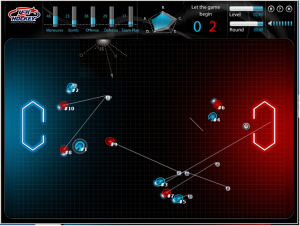The Ohio State women’s hockey team has added the Hockey IntelliGym to their training regimen this year, in order to improve the players’ cognitive abilities and hockey sense.
The Hockey IntelliGym is a downloadable program that aims to help players acquire and improve hockey sense by honing cognitive skills like anticipation and spatial awareness. On average, it yields a 30% on-ice improvement within the first year. The software has been adopted by several elite teams in North America, like the U.S. National Team Development Program, teams in the Canadian Hockey League, and the University of Notre Dame.

“It gives us another tool to be able to supplement the things that we do on ice,” Ohio State head coach Nate Handrahan said in an interview with The Hockey Writers. “The IntelliGym gives us an opportunity to help players understand the game a little bit more and at a deeper level.”
The IntelliGym software was developed through a two-year collaborative effort between Applied Cognitive Engineering (ACE) and USA Hockey from technology originally used to train air force pilots.
“We figured out that this could have a non-military use,” Danny Dankner, the CEO of ACE, told The Hockey Writers. “We realized that if you compare military flight to sports, there are many, many things in common if you think about the brain workload and the cognitive challenges; for example, working in teams, being able to anticipate more, the need to respond, the need to evaluate a few options and then select the right option, the very acuteness to divide your attention among a few things at the same time, and so and so forth.”
Dankner stressed that the IntelliGym does not teach specific hockey plays and systems, but instead looks to train “the fundamental brain skills that are related to hockey”, such as divided attention, anticipation skills, spatial perception, and long-term focus and concentration.
“Hockey is a very, very fast-paced game,” Dankner said. “You really need to be able to read and react very fast.”
After training with the program, players have shown an improved ability to handle that fast pace.
“You know what’s going to happen,” Dankner said. “You know how the ice sheet is going to look three, four, five seconds down the road and you play accordingly.”
Enhancing such skills was Handrahan’s goal in having his players start using the IntelliGym, and he has already started to see improvements on the ice.
“I think the basis of the IntelliGym program is to really help the cognitive reactions, to help us understand where we need to be on the ice,” Handrahan said. “I’ve seen players evolve from where they were always being a step late to being able to anticipate the play.”
The IntelliGym is a downloadable program that can be used on any personal computer with an Internet connection. In a demo of the software on the IntelliGym website (the first video on the right here), it has an almost game-like design, with the player controlling spaceships. Dankner noted, however, that it is very different from a video game.
“The main purpose of a video game is to have fun and to entertain a player,” he said. “You think about what are the fun elements and you think about stories and fantasy storyboards…but when you think about a training system, it is the other way around. The main purpose of this program is to make you better on the ice.”

Dankner said that because of that, “you start designing backwards”, by identifying the cognitive skills that are needed in hockey, and then thinking about the “cognitive workload that is needed in order to put this together.” After coming up with a broad metaphor, in this case the spaceships, he said that those elements are all combined to create a focused training program.
Dankner also noted that the IntelliGym is not a hockey simulator. “We do not expect the players to think about hockey when they are playing for this training,” he said. “We just want them to think about the instructions that they got on how to get to the bunker, which is the metaphor that we use, and how to maximize your score.”
Each session lasts about a half hour. According to Dankner, the best way to use the IntelliGym is to have two nights’ sleep between training sessions, in order to ensure that the brain gets proper rest. He also said that the recommended age for players to start using the IntelliGym is 10 years old, and there is good reason for that.
“In order for the IntelliGym to be worthwhile, you need to have some hockey fundamentals in place,” Dankner said. “You need to know how to skate and how to shoot and how to receive passes. You can be a theoretical hockey genius but if you cannot execute, it will not be seen on the ice.”
Handrahan said that it can be “taxing” on his players, because they are student-athletes with many other commitments, so he has made it an athlete-driven system with individual sessions instead of a mandatory program.
“I kind of expected early on that we would maybe see some slow usage early until the athletes see some results,” Handrahan said. “I think that the majority of the athletes that are out there, whether in hockey or other sports, when they start to see the benefits, they tend to do it more.”
Dankner said that they have found the same improvements cognitive-wise between males and females, but interestingly, they have seen a difference in how the two use the program.
“What we have found is that female hockey players seem to be more consistent with the training and more committed to the program,” he said. “You look at their training regimen and the actual training execution, [females] will be on the charts and doing what they’re expected, while males usually will be more, this week they will do it three times, next week they will do just one. And so they are not as consistent and obedient as far as the training program.”
Though Dankner doesn’t have a scientifically-proven reason for those findings, he has gotten feedback from coaches, and the general consensus seems to be that it is due to a difference in attitude.
“You work with girls, they will usually be more obedient; they will be more of a team player so to speak,” Dankner said. “With boys, they want to make themselves more appealing and more scoutable.”
Dankner said that the program is used by a very wide range of players, not just elite talents. According to him, because of the “very advanced training algorithm” it was designed with, hockey players at all levels can use the IntelliGym to improve.
“It is aimed to keep every trainee on his toes so it cannot be too frustrating if you’re learning a little slower and it cannot be too boring if you’re really a hot shot,” Dankner said. “It is adapted for age, for level, and for different profiles of the players.”
Dankner also stressed the importance of continuing to use the IntelliGym even after improvement flattens out as it follows the “classic learning curve.”

“Just like other training and skill acquisition, you can see if you stop training after a while you can see a drop,” he said. “The improvement will not be as dramatic as it seemed to be in the beginning but the training is needed in order to retain your skills.”
Dankner said that on-ice improvement is typically seen after eight to 10 training sessions, which would be at about the five-week mark for players training with it twice a week.
“Interestingly enough, we notice that the coaches normally see the improvement and change before it shows in the stats,” he said. “The coaches seem to know their players very good and know exactly what they’re expected to do, and then after like five or six training sessions you hear the coaches say, ‘Hey, look at Johnny here, I’ve never seen him do anything like that before.’ So before it shows actually in the numbers, the coaches can actually see the results even before the 10 training sessions.”
Handrahan feels, though, that his players are now seeing the results themselves and are “buying in.”
“I think that when they do a couple of sessions, and then see some on-ice results, I think that the response is to do a couple more right away,” Handrahan said. “So there’s a factor there of, ‘O.K., I did this, on the ice I did better, O.K., I’m going to do more of it.’ And we’ve seen that.
“We’re at the beginning of seeing some benefits of it, so I’m hoping those continue.”